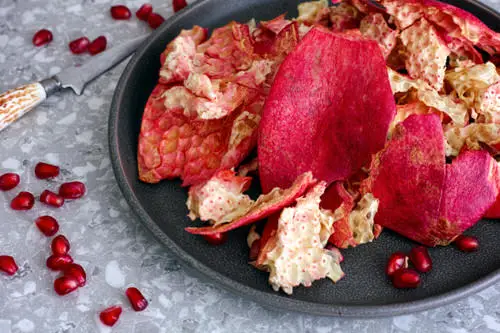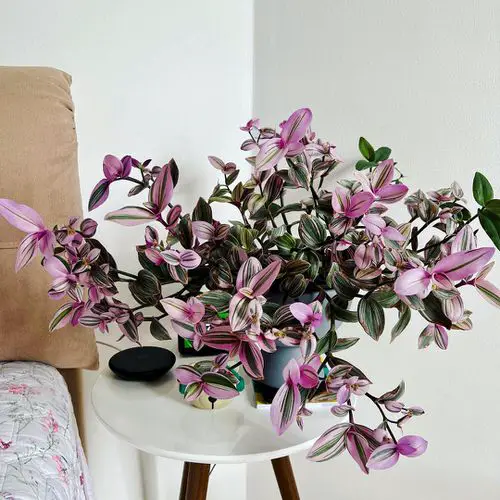Do you know about these incredible Pomegranate Peel Uses in the Garden? Read ahead to discover how it can be helpful for your plants!

Check out some amazing, scientifically proven Pomegranate Peel Uses in the Garden that will help your foliage plants to have lush growth and herbs and salad greens to have more flavor!
Have a look at some awesome banana peel uses here
What Pomegranate Peel Contains & How it Helps?
Pomegranate peel (Punica granatum) is rich in ellagitannins, flavonoids, proanthocyanidin compounds, and minerals such as magnesium (0.2 percent), calcium (0.1 percent), potassium (1.6 percent) with traces of sodium and phosphorus. The peel also has micronutrients such as copper, zinc, and iron, the pH value in rind is 4.8.
Being rich in potassium and magnesium means it helps in root development, improves photosynthesis, increases resistance to fight stress and drought, and also helps to boost the plants’ protein content. Applying this regularly can make your plants have a deeper color and lush growth!
Pomegranate Peel Uses in the Garden
1. Pomegranate Peel as Liquid Fertilizer

Make small pieces of the peel, add them to a blender with water, and make a thick and smooth slurry. You can also include a handful of pomegranate seeds into it, as it is rich in hydrolyzable tannins, condensed tannins, flavonols, anthocyanins, phenolic and organic acids, and other important minerals, which can be helpful for a plant’s growth.
So, it will be a good idea to add a few of its seeds, along with the peels, while making the liquid fertlizer.
- Take one part of this paste, dilute it with five parts of water, and use it to water the plants every once in a while.
Note: Pomegranate peels are rich in potassium. Hence you can use the fertilizer to feed your vegetables like tomatoes, broccoli, and cabbages. The peel also has magnesium, so you can use the fertilizer on rose, annual flowers, ferns, and pepper plants.
2. Pomegranate Peel Fertilizer Spray

You can use pomegranate peels to make this DIY foliar spray. It will be a great booster for the lush foliage. For this, you’ll need pomegranate peels, Epsom salt, eggshells, and water.
Mix 2 tablespoons of powdered pomegranate peels or their paste and crushed eggshells in one liter of water. Add half a teaspoon of Epsom salt, stir well, and use it on plants occasionally when you see the need.
3. Pomegranate Peel as Dry Fertilizer

According to a study by the University of Vigo, Spain, pomegranate peel is loaded with micronutrients and valuable bio compounds. All this can give a good boost to the plant’s overall growth.
- Chop the peels, spread them on a newspaper, and place it on a sunny balcony.
- The drying process will remove moisture without decreasing the nutritional value.
- Make a powder by grinding the dry peels in a grinder.
- Store this powder in an airtight container and use it whenever you want.
Direction for Using Pomegranate Peel Powder:
Spread 2-3 teaspoons of this powder around the base of plants in pots, once in 5-8 weeks. For garden plants, use 4-5 teaspoons per plant.
4. Pomegranate Peel Tea Elixir

Prepare this fast-release fertilizer that can be used as a foliar spray. For making this tea, add 100 grams of pomegranate peel to a vessel, fill 2 liters of water, and cover it with a muslin cloth.
Keep the vessel in a bright and dry location for 4-5 days. Once done, dilute the tea with 2 more liters of water and apply it on plants as a foliar spray.
5. Pomegranate Peel in Compost Pile

Pomegranate peels are biodegradable and break down easily, so add them to the compost pile. Make sure to chop or soak the peels before adding to compost, do not add them whole.
6. For More Flavorful Herbs

It has been found in this research that pomegranate peel (PP) as an organic fertilizer has positive effects on the growth of essential oil content in the sage plant (Salvia officinalis).
The idea is that you can also use pomegranate peel fertilizer on other herbs like basil, rosemary, cilantro, and oregano. It will also make their foliage lush while boosting their flavor and fragrance.
Check out the best secret homemade fertilizer recipes here
7. Control Plant Diseases

To save the plant from a number of potential soil diseases, add the peels to a blender and make a fine powder. Use this to side-dress plants. You can also make a paste by adding water to the powder and coating the stems of the garden plants to keep the potential bacterial and fungal infections at bay.
Using pomegranate peel around plants is an eco-friendly approach for preventing viral plant pathogens and infections. The application of pomegranate peel extracts works on both pre and post-harvest diseases in citrus fruit decay in storage and shelf life.
Its extracts also have a diverse range of antimicrobial effects. Also, the wide availability of pomegranate peel as a by-product of processing factories contributes to its low cost. It is also environmentally friendly, too!
It has been proven in this study that the application of pomegranate peel around plants is a natural treatment for controlling plant diseases and is effective against Botrytis cinerea, Penicillium digitatum, Alternaria alternata, Stemphylium botryosum, Colletotrichum acutatum sensu stricto, Fusarium wilt, Aspergillus parasiticus, Monilinia laxa, and Monilinia fructigena without any side effects.
Pomegranate Peel for Houseplants

Pomegranate Peel as Liquid Fertilizer is best for famous houseplants like inch plant, aglaonema, pothos, philodendron, snake plants, spider plant, fiddle leaf fig, different herbs, and rubber plants. It will promote lush growth of the foliage while making the edible plants more flavorful.



Intresting piece of information 👍.